The structure and relationships of marketing personnel, including lines of authority and responsibility that connect and coordinate individuals, strongly affect marketing activities. People in the organization carry out activities of marketing.
Marketing management, therefore, cannot take place except within a specific organizational setting. The organizational setting is termed as ‘marketing’s home.’ Thus an understanding of organizational issues will help all marketing staff members better coordinate their efforts with others in their firm.
Marketing Organization Definition and Meaning
A company’s marketing organization includes any position within that company where marketing activities occur.” The boundaries of a marketing organization cannot always be clearly identified for two reasons. First, all marketing activities do not always occur in the same organizational location in the organization.
A large firm with many product lines, for example, may have a separate salesforce under each product manager, where you may find a centralized shipping operation that is supervised by the manager in charge of procurement.
Second, different firms may categorize their activities differently. For example, one firm may consider pricing as a part of marketing, wherein the other firm may be considered a finance activity. It means that marketing activities differ among firms.
Even if a company has a formally identified marketing department on its organogram, all the marketing activities performed in that firm may not be confined within the marketing department.
You can also view the marketing organization in a slightly different way. You may consider it a collection of persons in various positions in the marketing department. You may fail to distinguish between the people and the activities identified on the organogram.
To be effective, therefore, the marketing organization should be precisely defined, mentioning the specific responsibility of each of the marketing personnel.
3 Purposes Served by the Marketing Organization
A marketing organization is definitely created to serve certain purposes for the company. It helps the firm serving quite a few purposes. Among the purposes served by the marketing organization of a company, three are noteworthy. Let us now look at them in brief:
1. Marketing Organization Facilitates Effective Response to Market Needs
A firm needs to identify the changes taking place in the market and a competitive environment and respond accordingly.
There are many ways of identifying changes and responding to them at a firm’s disposal. The firm should decide which of the available alternatives to identifying and responding to changes should be followed. For example, a firm may identify changes using its marketing intelligence system or by conducting marketing research or so.
Regarding response, it may respond to changes in competitors’ strategies by developing and launching a new product or modifying its existing product. The option that a firm will select by the type of its marketing organization and people in it.
2. Marketing Organization Helps to Carry Out Activities with Optimum Efficiency
Specialization, along with coordination and control, helps the firm achieve internal efficiency.
Many specialization options are available to a firm, such as customer, geographic, and product specialization. We shall discuss them in detail later in this lesson. Coordination becomes more important as a firm becomes more flexible in its organizational structure.
Control here is related to authority and responsibility structures. If it is found that progress does not conform to the standards set, the responsible executive must be made aware of this, and he must have the authority to take necessary action. It is also his responsibility to monitor the progress of his subordinates closely.
3. Marketing Organization Helps Represent Customers’ Interests within the Company
The importance of customers takes a new meaning in the firm if the management takes a marketing approach. The marketing concept suggests that a firm’s existence depends on sensing and satisfying customers’ needs in a way better than the competitors do.
For ensuring customer needs and problems receiving proper representation inside the corporate domain, some parts of the organization must take this as one of the fundamental responsibilities.
Customer orientation is provided in some firms by charging every employee from the president down to the very junior staff to maintain a customer perspective in all functions and responsibilities.
On the contrary, other firms respond to customer interests more tangibly, but somewhat passively, via complaint departments or attitude surveys carried out by marketing research personnel.
But when carried to its fullest, this responsibility goes beyond research or complaints departments and includes an inhouse customer advocate with a top management position’s authority and independence.
The overall purpose of a marketing organization is to help attain marketing objectives. The organization is not an end in itself but rather a means to coordinate and direct many people’s varied work to achieve a unified and successful result.
Role of Marketing Organization – Marketing’s Place in an Organization
This section looks at the place of marketing within an organization. Marketing’s place within a company is largely determined by whether the firm is production, sales, or marketing oriented.
A production-oriented company concentrates either on improving production efficiency or on producing high-quality, technically improved products.
Here, objectives and planning are determined by the executives in the production and engineering departments. The company emphasizes simplified and mass production and tries to keep the unit cost low. Marketing plays no role in the true sense in such a situation.
Price is dictated by production and finance departments, and the function of the sales department is to sell the organization’s output. Thus there is a notable absence of consumer consciousness.
With the expansion of the market, manufacturers recognized the importance of other marketing functions and started changing their company structures.
In a sales-oriented organization, there is a general belief that personal selling and advertising are the primary tools used to generate profits and that most products – regardless of consumers’ needs – can be sold if the right quantity and quality of personal selling and advertising are employed.
Thus, the sales and advertising managers are at the same level in the company’s hierarchy: the production, personnel, and finance managers, and all participate in top-level management.
Higher-level sales and advertising executives and other executives at the same level are involved with setting the company’s overall policies and objectives.
The marketing concept suggests that marketing starts with the customers and works back to producing desired products in the right amounts and with the right specifications. As the figure below shows, the marketing manager is in a position equal to that of the personnel, production, and finance managers in a marketing-oriented organization.
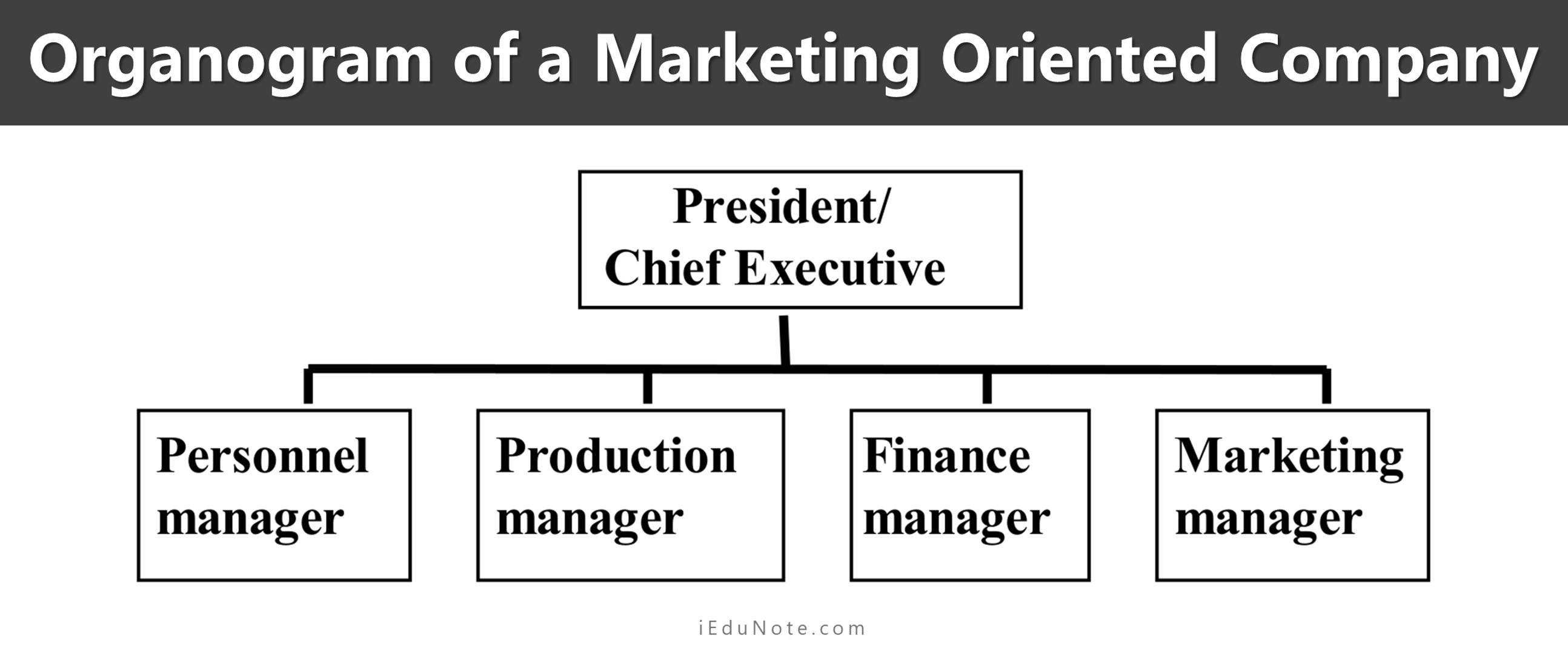
This structure allows the marketing manager to participate in top-level decision making. Note, too, that the marketing manager is responsible for various activities (not shown in this figure), several of which are under the jurisdiction of other functional managers in production or sales-oriented firms.
Relationships between marketing and other functional areas such as personnel, production, finance, and marketing’s importance to management heavily depend on its basic orientation.
Marketing encompasses the greatest number of business functions in a marketing-oriented firm, and it occupies an important position in the organization.
Relations That Exist Between Marketing and Other Departments When a Firm is Marketing Led: You should know that the marketing concept advocates synergism.
In a marketing-oriented company, the marketing department coordinates intra-department activities and coordinates with the activities of other departments to get a synergistic result. Becoming marketing-oriented means carrying out both internal and external marketing.
By internal marketing, we mean successfully hiring, training, and motivating employees to serve the customers well and satisfy them. Internal marketing is to be carried out first because unless a company is not ready to provide customer satisfaction, it cannot go for external marketing.
In a marketing-oriented firm, the focus is on customers’ needs rather than selling. The executive responsible for marketing is named marketing manager, marketing director, or marketing vice president.
His job is to coordinate all marketing activities and liaison with other departments in the organization to effectively and efficiently perform marketing activities and attain a profitable sales volume through satisfying customers. The domain of marketing also changes.
The activities which were previously under other departments come under the jurisdiction of the marketing department. The status of marketing people also changes with the adoption of the marketing concept.
Marketing comes at the foreground of company operation, and the entire company works to develop, manufacture, and sell a product from the marketing point of view. The importance of different levels of management also changes with the adoption of the marketing concept.
Customers come at the top of the organization and then come front-line people who meet, serve, and satisfy customers.
Middle management supports front line people so that they can better serve customers, and top management stays at the base to support middle management so that they can effectively and efficiently provide support to the front line people.
In a marketing-led company, the marketing manager has to perform two important tasks. First, he needs to coordinate internal marketing activities.
Second, To serve customers well, he needs to coordinate marketing with other company departments as finance, production, etc. There is little agreement on how much authority and influence marketing should have over other departments regarding the second task.
The normal practice in different organizations is that the marketing manager works through persuasion rather than authority. It is seen that other departments usually are reluctant to bend their efforts to meet the customers’ interests.
They are rather interested in their departmental works, where marketing is interested in meeting customers’ needs reasonably well. It leads to a conflict of interest between marketing and other departments.
By studying the following table, you will understand the differences in orientation between marketing and other company departments.
To attain its goal, the marketing department should minimize the differences by taking a persuasive approach and making other departments adopt a marketing perspective.
They should be convinced that it is impossible to win customers’ hearts and sustain in the face of competition without joint efforts. Understanding this philosophy by all, is a prerequisite for the firm to become truly marketing led.
Organizational Conflicts Between Marketing and Other Departments Within The Company.
| Department | Department Emphasis | Marketing Emphasis |
| R&D |
|
|
| Engineering |
|
|
| Purchasing |
|
|
| Manufacturing |
|
|
| Operations |
|
|
| Finance |
|
|
| Accounting |
|
|
| Credit |
|
|
Organizing Marketing Unit – Major Alternatives in Organizing the Marketing Unit
How effectively a company’s marketing management can plan and implement marketing activities depends on how the marketing unit is organized. The organizational structure of a marketing department establishes the authority relationships among marketing personnel and specifies who is responsible for making certain decisions and performing particular activities.
In organizing a marketing unit, managers divide the work into specific activities and delegate responsibility and authority to persons in different positions within the marketing department.
They include, for example, the research manager, sales manager, and creative manager. This internal structure provides the vehicle for channeling marketing activities.
You should note that no single approach to organizing the marketing department works equally well in all organizations.
A marketing department can be organized according to functions, products, regions, or types of customers. The specific approach(es) that is (are) best depends on the number and variety of the company’s products, people’s characteristics and needs in the target market, and other factors.
We shall now consider each organizational approach at some length :
1. Functional Organization
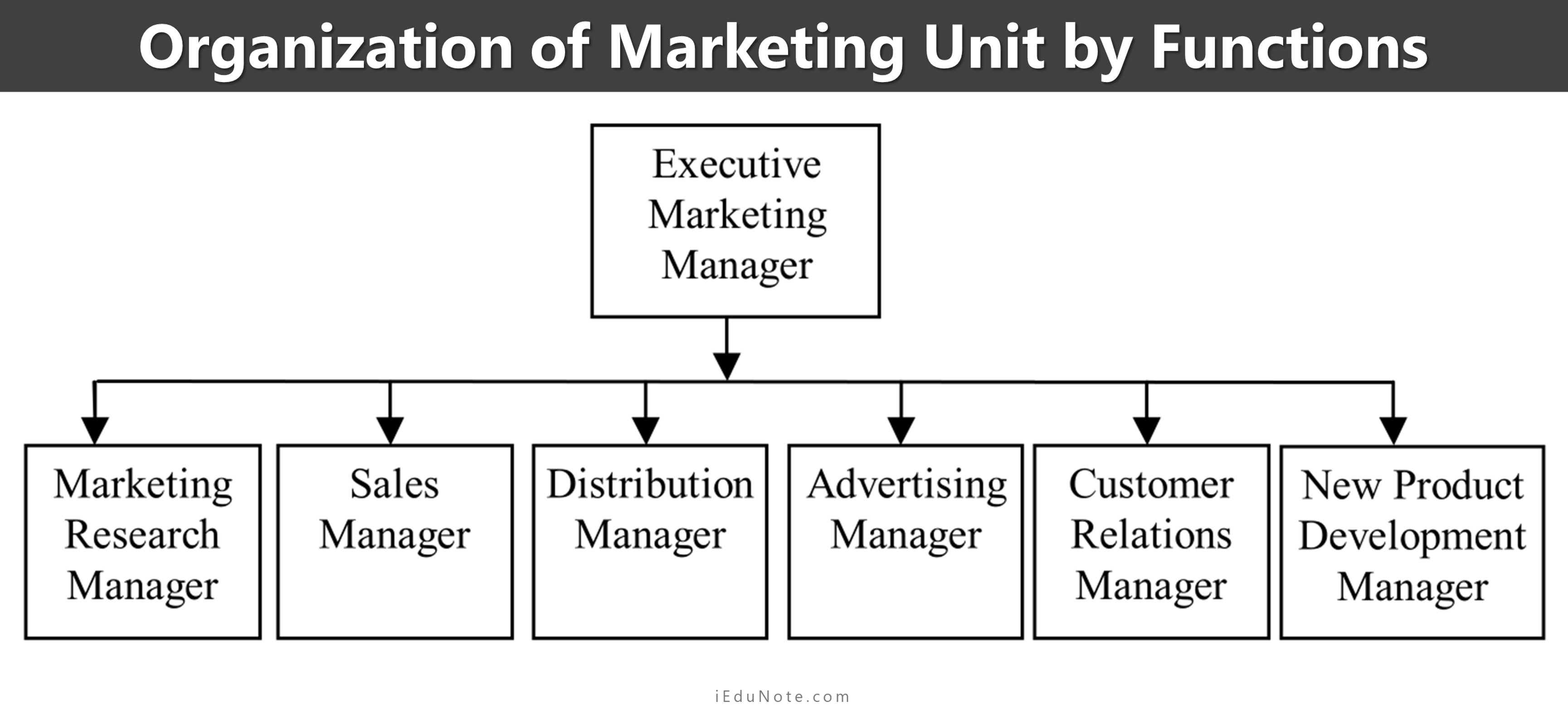
Some marketing departments are organized by general marketing functions such as marketing research, product development, distribution, sales, advertising, and customer relations.
As shown in the figure, the personnel who direct these functions report directly to the top-level marketing executive.
This structure is fairly common because it works well for small businesses with centralized marketing operations. In large firms with decentralized marketing operations, a functional organization can raise severe coordination problems.
However, the functional approach may be useful in a larger centralized company in which the products and types of customers are neither numerous nor diverse.
2. Product Organization
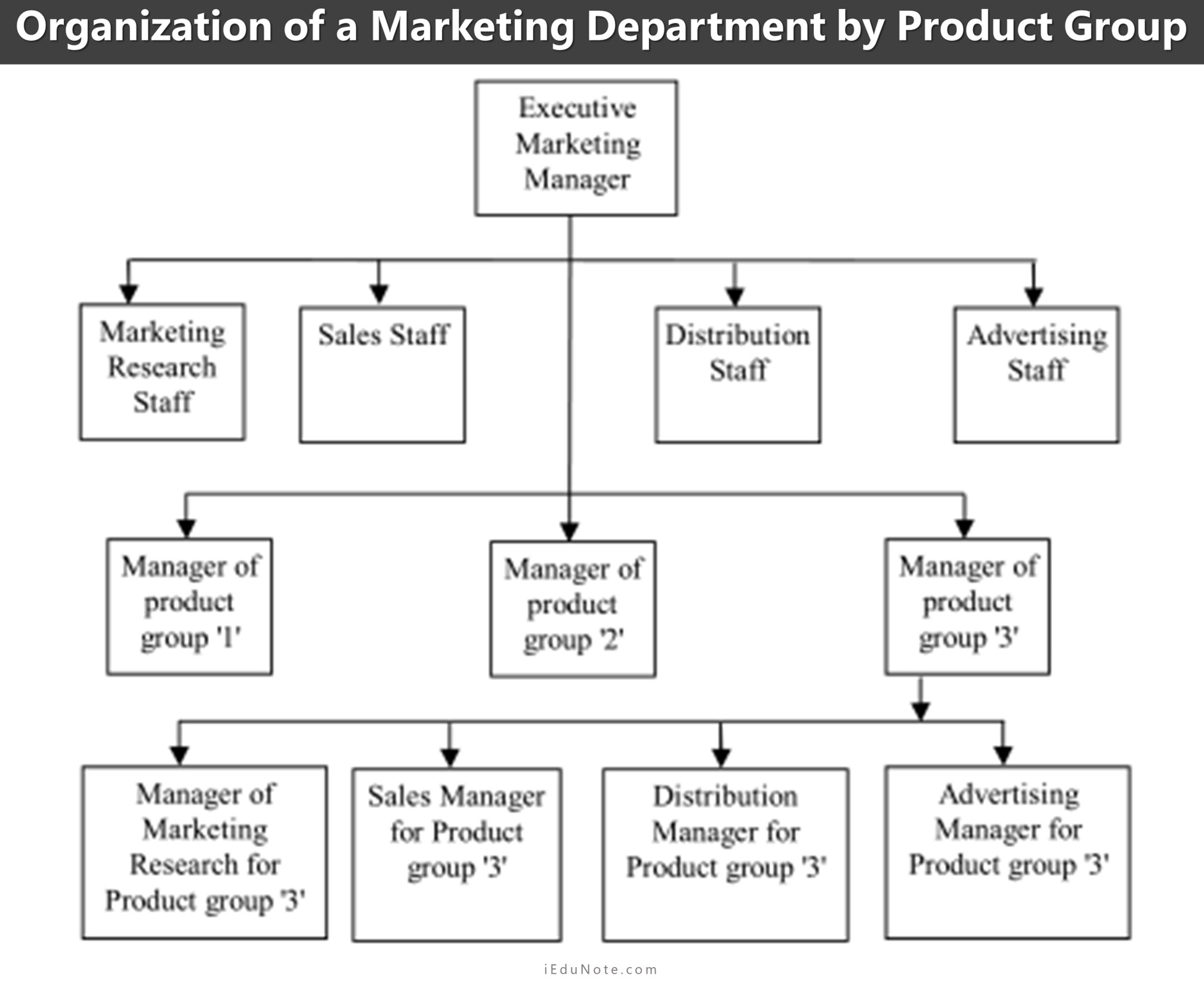
For an organization that produces and markets diverse products, the functional approach may be inadequate. The decisions and problems related to a single marketing function for one product may differ from those related to the same marketing function for another product.
For this reason, organizations that produce diverse products sometimes organize their marketing department according to product groups. In this type of organization, a product manager takes full responsibility for marketing a product or product group.
As shown in the figure, the product manager for the product group ‘3’ has authority over the functional managers lower in its hierarchy. The product manager may also draw upon the resources of specialized staff in the company.
Organizing by product groups gives a firm the flexibility to develop special marketing mixes for different products. The firm can hire specialists to market specific types of products.
One disadvantage or organization by-products is that different product groups may duplicate some marketing activities. For example, salespersons from three product groups may call on the same customer in a single day.
3. Regional Organization
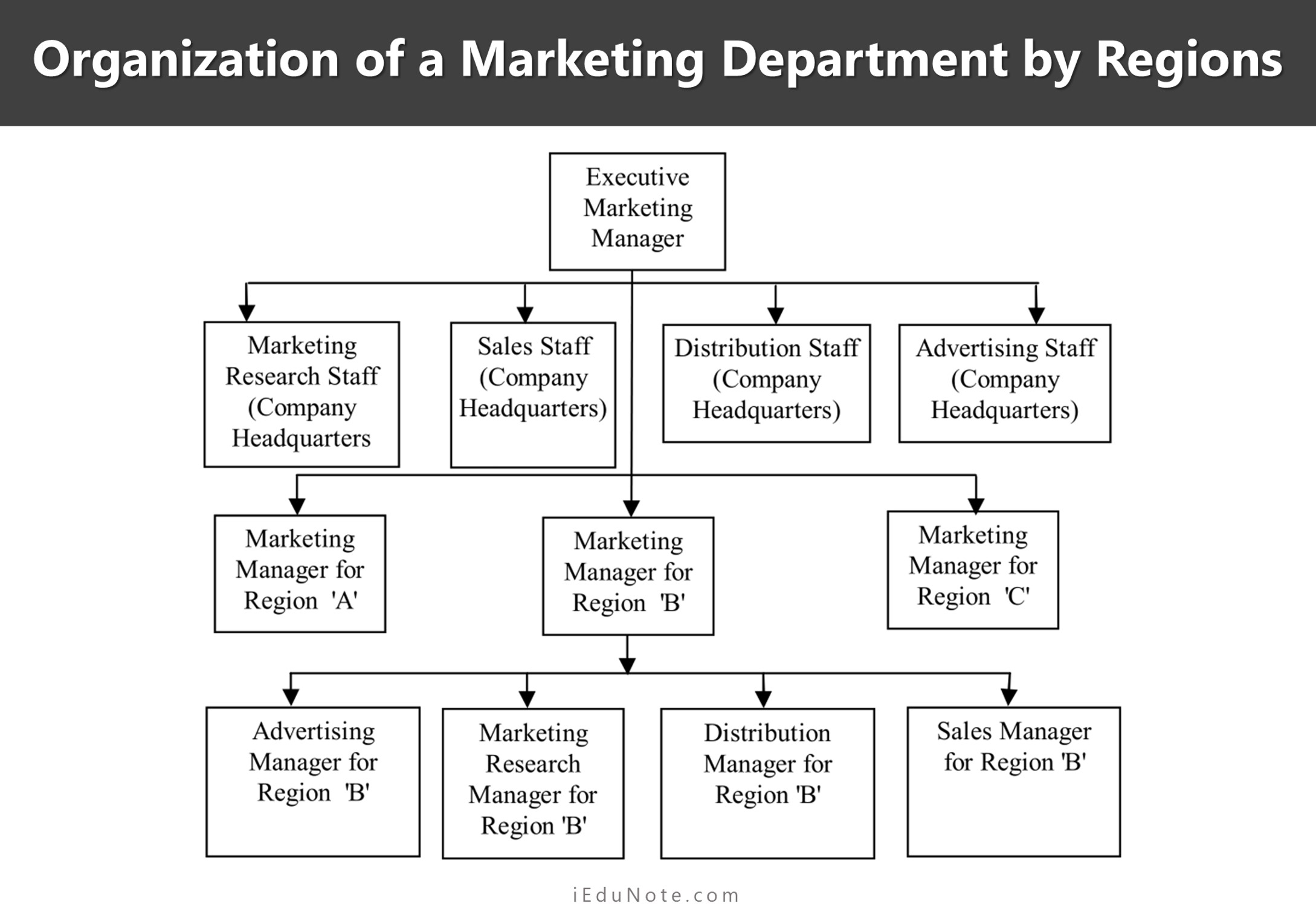
A large firm that markets products nationally and possibly in foreign countries may organize its marketing activities by geographic regions.
All the regional marketing managers report directly to the executive marketing manager. Managers of marketing functions for each region report to their regional marketing manager, as shown for region ‘B.’
This organization’s form is especially effective for a company whose customers’ characteristics and needs vary greatly from one geographic area to another. The company has a complete marketing staff at its headquarters to provide assistance and guidance to regional marketing managers.
However, not all firms that organize their marketing department by region have a complete top-level unit. Companies that try to penetrate the national market intensively sometimes divide regions into sub-regions.
4. Customer Type Organization
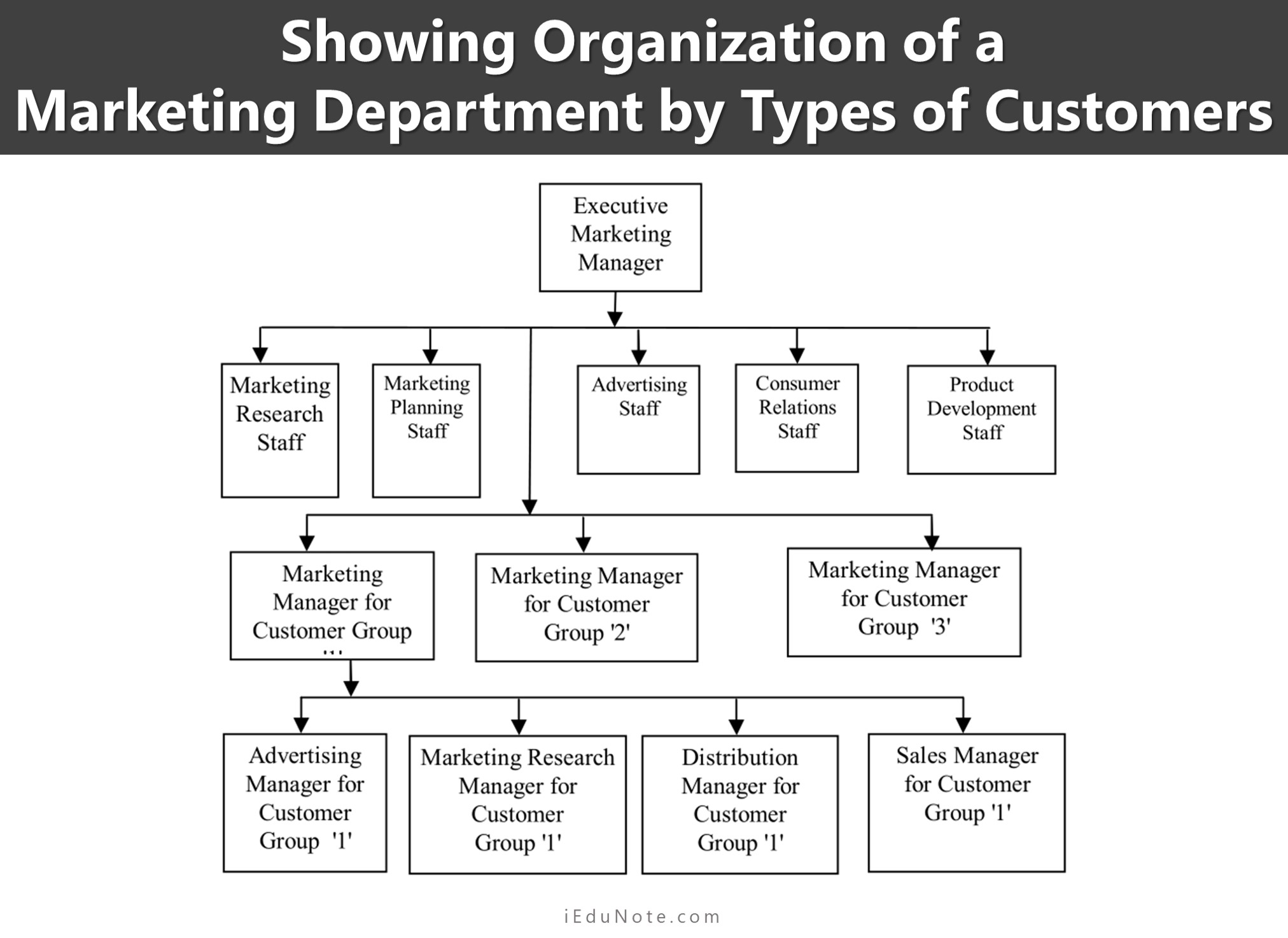
Sometimes the marketing department is organized according to types of customers, as shown in the following figure:
This form of internal organization works well for a firm with several groups of customers whose needs and problems are different.
For example, an appliance manufacturer may sell appliances to large retail stores, wholesalers, and organizations.
Because the marketing decisions and activities required for these three groups of customers differ considerably, the firm may find it more efficient to organize its marketing department by types of customers. Retailers may want more rapid delivery of small shipments and more personal selling by the producer than wholesalers or organizational buyers.
The marketing manager for each customer group reports to the top-level marketing executive and directs most marketing activities. Usually, the managers of various marketing functions handle the activities needed to market products to a specific customer group.
Using Several Bases for Organizing
You may have noticed that the above three figures (product, region, and customer) show more than one organization type.
In the product type organization, the marketing department is organized by-products, but each product manager has authority over functional managers within the product groups. A similar condition exists for the marketing department organized by regions and types of customers.
It is common for a company to use some organization by-products, functions, customer types, or regions. Product features may dictate that the marketing department be structured by-products. Customers’ characteristics require that it be organized by types of customers or by geographic region.
Using more than one type of organization, a flexible marketing department can develop and implement marketing plans to match customers’ needs.